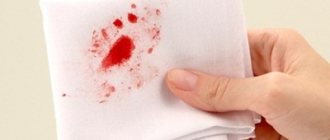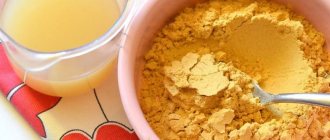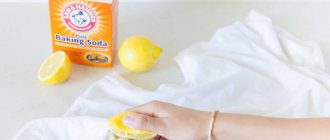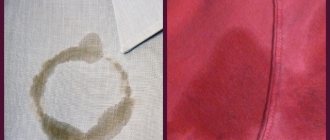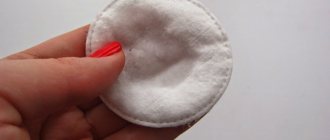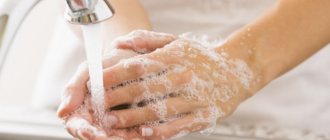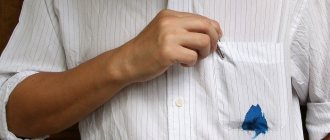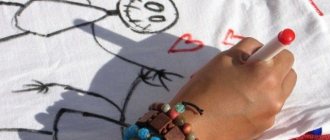The effectiveness of removing stains caused by hair dye from fabric will directly depend on both the type of dye and how dirty the clothing is.
If hair, eyebrow or eyelash dye has been applied to pure white cotton fabric without a print, then bleach will help get rid of it. Soaking the item for 1-2 hours in cool chlorinated water will be enough. Bleach is suitable both in powder and tablet form.
Attention! Only cold water is used for soaking in bleach. Hot water increases the causticity, the fabric will become thinner.
If you need to remove dye stains from synthetic or woolen items, you need to mix 1 tablespoon of powder (dishwashing detergent is suitable) and 1 tablespoon of vinegar diluted in 400 ml of water. The resulting mixture is applied to the desired area, moistened with warm water. Then you should leave everything for a while and then rinse thoroughly. The stain may not come off the first time, then repeat this procedure.
How to remove traces of henna from clothes?
To get rid of traces of henna on clothes, a mixture of adding hydrogen peroxide and ammonia (40 ml each) to a glass of water in equal proportions will help. 20 minutes after application, rinse the solution with warm water.
How do you remove hair dye from clothes?
It is advisable to deal with sudden stains as quickly as possible after detection, since in this case the stains are easily susceptible to chemical attack and come off easily. With neglected or numerous stains, it is easier to part with the item than to remove those very hated stains.
Advice! Before applying stain remover, test on an inconspicuous area on the underside. A proven method will eliminate the unplanned reaction of the material to chemical exposure.
Hair dye removal methods
Fresh dirt is easier to wipe off. Rinse it thoroughly in cold water and wash as usual with the addition of washing powder.
Hairspray is great for fighting fresh stains. Spray the varnish onto the surface, rub and wash in warm water with detergent. The method is widely known in beauty salons.
Hydrogen peroxide, which is poured directly onto the stain and left there for up to half an hour, will get rid of a long-standing stain. Then wash in the usual way.
An excellent remedy for colored fabrics is 9% table vinegar. It is safe for fabric color and adds richness. The vinegar is left on the desired area for 20 minutes, and then you need to rinse and wash the item.
Attention! Do not use acetic acid, apple cider vinegar or wine vinegar.
Solvents can be used on bright fabrics: gasoline, acetone, kerosene, white spirit. They are considered more effective than vinegar or hydrogen peroxide. Apply the solvent applied to a cotton pad to the contaminated area.
Attention! Check the reaction of the material to the solvent on the reverse side of the product before applying it to the front side.
If such an annoying problem occurs on white fabric, the use of aggressive agents will be much more advisable. Antipyatin soap is an effective solution. Rinse the soaped area of fabric under running water and wash with conditioner after 20 minutes.
The following remedy will help you get rid of a stained area from snow-white cotton fabric: 10% ammonia solution (1 tablespoon), hydrogen peroxide (1 tablespoon) and 1 glass of water are mixed, slightly heated and applied to the stain using a cotton pad. After 10 minutes, wash the product with fabric softener.
When using oxygen bleach, pay attention to the rules of use outlined in the instructions for it. There will be no trace left of the stain, and the brightness and quality of the pattern will remain unchanged.
If a plain white item is dirty, soaking it in cool water with the addition of “Whiteness” will do. Soaking time is about 2 hours.
Sunflower oil is also used to remove stains. A small amount is applied to the contaminated area and wiped with a cotton ball. Once the stains are gone, apply dish soap (this will help remove any remaining oil) and wash.
We act according to science
Hair dye is a complex chemical compound. So, to remove stains from it, you will have to involve science that studies these very compounds and the reactions between them. In the process of work, do not forget that when removing stains, for example, from dyed textiles, the design may be damaged, so in order to avoid irreparable consequences, cleaning any materials is recommended
- do not use chlorine bleaches or solvents such as “White spirit” on artificial and colored natural fabrics;
- test the selected product on an inconspicuous area of fabric (for example, on an internal seam) or any other material.
Neutralize traces of hair dye
The surest way to do this is to begin a campaign to “destroy the enemy” as early as possible. There are several options for removing fresh stains.
How to scrub with cold water and laundry soap
To remove stains, you can use not only brown, but also white laundry soap
A fresh “blot” of hair dye can be washed off with cold running water. If the size of the item allows, then the dirt just needs to be placed under the stream, and if we are talking about something bulky, for example, a carpet, then you need to wet a brush or sponge with water and wipe away the mark. Is the stain still visible? Indispensable laundry soap will come to the rescue. We wash the problem area and rinse with cool water. After which we either wash the product in the usual way, or clean it in another suitable way (for example, the rug should be vacuumed with carpet detergent).
This is interesting. Rub the stain from the edges to the center to prevent it from spreading over the surface of the material.
Wet wipes
Fresh hair dye can be easily wiped off with wet wipes from skin, furniture and floors.
This is interesting. This method can also be used to clean hard surfaces.
How to clean with hairspray
Hairspray not only sets your hairstyle, but also removes hair dye stains well.
If a thing is damaged by hair dye, then you can try to bring it back to life using a product for curls - varnish.
Instructions:
- Spray varnish onto the dirt.
- Okay, three.
- We wash as usual.
How to remove with soda and vinegar
These components, when interacting with hair dye components, neutralize coloring pigments.
Instructions:
- Take baking soda and vinegar in equal parts and mix.
- Apply the paste to the stain.
- We wait until the trail goes away.
- Wash off with warm water.
This is interesting. Of the described remedies, the most effective are laundry soap and a mixture of soda and vinegar. If the first removes fresh paint without a trace, then the second has a better chance of winning in the fight against older ones.
Oxidizing stains
The chemical reaction that accompanies the combination of a substance with oxygen makes it possible to remove coloring pigments from any surface.
Oxidizer for paint
You can remove hair dye stains on the skin using an oxidizing agent.
The same one that comes with the hair coloring kit. To do this, however, you will need another package of paint, since you use the “native” one for its intended purpose, and not for cleaning. I'm glad that you can buy inexpensive paint to remove old stains. Simply apply the product to the area of contamination, rub and remove the residue with a wet cloth.
How to remove a stain with peroxide
For the desired result, the stain must be soaked generously with peroxide and allowed to soak.
Hydrogen peroxide solution is available in any home. And besides medical purposes, the product does an excellent job of removing stains on various materials.
This is interesting. And although there is no difference between using products for natural and artificial leather, you should still be careful with substitutes: the reaction of the material to any stain removers is impossible to predict.
Instructions:
- Place a cotton pad soaked in peroxide on the paint mark.
- Let it sit for 20 minutes.
- Soak the product in cold water.
- We wash as usual if the stain was on the fabric, or wipe it well with a clean cloth if it is not possible to wash it.
This is interesting. This method is usually used on light-colored fabrics. If the material is not natural, then you can try diluting the peroxide with water 1:0.5.
Hair curler "Curl"
Professionals in salons use “curl” to remove paint that gets on the client’s skin.
This is another proven method for removing hair dye stains from skin, floors or furniture. Typically, hairdressers remove with “Curl” any remaining product that gets on the client’s forehead and neck by moistening a cotton pad with it and wiping the contaminated areas.
This is interesting. When paint gets on products made of natural or artificial leather, then using peroxide, ammonia and other products that match the color is quite dangerous: if you do not wash off the top layer of coating, you can change its shade. Therefore, professional hairdressers recommend using the same stain removal methods that are used to cleanse human skin that has been touched by dye during the hair coloring process. And in this rating, the undisputed leader is the curling agent, hair oxidizer is one step behind it, and peroxide closes the top three.
Dissolving pollution
Chlorine bleach for fabric
For white fabrics, you can use both oxygen and chlorine bleach.
Removing stains from white fabrics is an undertaking that many consider doomed to failure. And yet we will try to turn the situation in the opposite direction. The chlorine bleach method stands at the top of the pedestal among the most affordable methods for removing stains from white natural fabrics. It is enough to apply the product to the stain, leave for the time specified in the instructions (from 5 to 20 minutes), and wash the item as usual.
This is interesting. On thick white cotton fabrics (for example, towels or bed linen), you can use acetone, thinner or gasoline: the stain is moistened with the product 20–25 minutes before washing, and then washed (perhaps even several times, since the smell of these products is very cutting).
Vanish Oxi Action stain remover (including for jeans)
Before using a stain remover, you should carefully read the recommendations for your specific fabric type.
Most often, at the time of dyeing, the clothes you are wearing suffer. And if at home it is possible to put on “what you don’t mind,” then when visiting a master, alas, this is hardly possible. But Vanish Oxi Action turns out to be a very effective tool for removing this kind of pollution. It must be applied strictly according to the instructions indicated on the packaging, suitable for your type of fabric. After you have applied Vanish to the stain and left it for the required time, the product must be washed with the addition of this stain remover.
This is interesting. Vanish Oxi Action does an excellent job of removing stains on jeans without leaving any whitish streaks after use.
Ways to wash with table vinegar
To eliminate the unpleasant smell of vinegar after treating a stain, the item must be washed and rinsed with conditioner.
Vinegar is considered a universal remedy, as it can be used on fabrics and other materials.
Instructions:
- Wet the stain with vinegar and leave for 30 minutes.
- Rinse.
- We wash in the usual way.
How to wash with a combination of glycerin, salt and vinegar
After applying glycerin to the stain, you need to wait 5 minutes for the product to be absorbed
This trio is able to dissolve the stain in front of an astonished audience in just a few seconds.
Instructions:
- Add glycerin to the stain and wait 5 minutes.
- Apply a few drops of saline solution (a kind of artificial brine - 50 g of salt per 1 liter of water).
- Add 1 tsp. table vinegar.
- If the stain is gone, wash the item in the usual way. If not, then apply 1 tsp. ammonia.
This is interesting. These stain removal methods are only suitable for fabrics that can be exposed to chlorine. That is, it is not suitable for delicate people. On thin fabrics you need to use the same products that are used for colored items.
Dishwashing liquid and vinegar for stains on carpet and rugs
If the carpet is light, then you can use peroxide, ammonia, etc.
It is much more difficult to remove stains from carpets or rugs, because even fresh stains cannot be washed thoroughly. And yet there is a way out.
Instructions:
- Mix 1 tbsp. l. dishwashing gel, 1 tbsp. l. vinegar and 2 tbsp. cold water.
- Wet a soft cloth with this solution and apply it to the stain.
- We turn the fabric over, wet it again and apply it to the carpet again. Repeat until the mark disappears.
- Wet the cloth with clean water and remove the remaining solution.
This is interesting. If the carpet is white or beige, then vinegar can be replaced with ammonia or peroxide. The proportions remain the same.
Ethanol
Alcohol can only remove stains from white or beige carpets
This method is only suitable for light-colored carpets and rugs. You need to moisten the mark with alcohol and wait 20 minutes until the stain dissolves. Then wash off the remaining stain remover with a cloth moistened with water.
Lemon juice
Suitable for processing delicate fabrics. Moisten a cotton pad with juice and wipe off the dirt.
Kefir for leather and leatherette
Used as a stain remover for delicate fabrics, light leather and leatherette.
Instructions:
- Wet a cloth in the milk product.
- Three spots.
- Leave for 10 minutes, rinse off.
This is interesting. The degree of effectiveness of these products depends not only on the material on which the stain got, but also on the shade of the paint. Of course, the most powerful are professional stain removers. But if the stain is from a light dye, it is small and gets on furniture or leather surfaces, then you can get by with kefir.
Using the “scrub effect”
After treatment with stain remover, the floor must be washed
For hard surfaces, you can use products that mechanically attack the stain.
This is interesting. The two methods presented are equivalent.
Soda and dishwashing gel
You can't do without baking soda when removing stains.
Instructions:
- Mix 1 tbsp. l. baking soda and 1 tbsp. l. dishwashing gel.
- Apply to the contaminated area and use a soft cloth.
- After the trace disappears, wash off the remaining product with warm water.
For cotton - ammonia, for jeans - kerosene
Depending on the fabric on which the contamination occurred, the method of removing stains also depends, since what is suitable for cotton items may be contraindicated for fabric made of neoprene or nylon.
How to remove stains from jeans?
Jeans differ in the density of the fabric. Washing denim is more difficult, but it has the advantage of being able to use stronger cleaning agents. Using kerosene or gasoline is suitable. Gauze folded in four layers is placed underneath, and the area is treated with the selected product. After ten minutes, rub generously with laundry soap and wash with the usual powder.
How can you wash cotton?
10% ammonia is perfect for cotton products. The item is placed in a solution of water and ammonia (in a ratio of 10:1), left for up to four minutes, then washed. It will be more comfortable to carry out this procedure on a balcony or in a well-ventilated room.
To avoid fabric damage, do not use several aggressive cleaning agents at the same time. If one thing does not bring results, be sure to wash the item before using the next cleaning solution.
Universal products for white and color
Getting rid of hair dye from colored fabric is much more difficult than from light-colored fabric. After using caustic solvents, bright colors may fade, and instead of dirt, a whitish tint from the former rich color will remain. Therefore, it will be more effective to use specialized tools.
- "Antipyatin." A well-known remedy that copes with various types of pollution. Rub the required area and let it soak for 15 minutes. If necessary, the procedure is carried out several times.
- Laundry soap. Rinse the area with paint under running water, lubricate it generously with laundry soap and wait ten minutes. Next, thoroughly rub the fabric with your hands and rinse with water.
- Glycerol. Wet the contaminated area with glycerin and leave for 20 minutes. Then a mixture of one teaspoon of 9% vinegar and a pinch of salt is applied to the treatment site. Waiting time is two minutes.
- Bleach. Industrial bleaches for colored fabrics are excellent at removing chemical dyes. When using, use the tips indicated in the instructions.
The methods described above are also great for cleaning lighter colored items. If the dye has become deeply absorbed into the fabric, rub the cleaning agent in a circular motion with a sponge or cotton wool. This way it will penetrate into the deeper layers of the tissue, which will help remove the stain.
Expert recommendations
Most fresh paint stains can be effectively removed by regular washing. The main rule is to do this immediately, before the pigments have time to penetrate into the small fibers of the material.
If more than 15 minutes have passed since the paint hit the item, difficulties may arise when trying to remove the stain. A regular stain remover will help. Obsolete contaminants that have had time to dry and be absorbed can remain on the material forever, despite the entire arsenal of products used.
Although there is a wide range of methods for removing paint from leather, in some cases it is impossible to remove the stain. Then the thing remains hopelessly damaged. Therefore, during preparation, in the process of applying and keeping the dye on your hair, you should use clothes that you don’t mind getting dirty.
Everything just happened: ambulance
The success of removing dye from fabric depends on the speed at which cleaning actions are taken. Fresh hair dye on your favorite T-shirt is much easier to remove.
How to remove dye from clothes at home?
Once a stain is discovered, remove the affected item immediately and rinse under cool, low- to medium-pressure running water. Water should flow down the fabric without penetrating inside, as there is a possibility that the dye may penetrate deeper into the fibers. If you react in a timely manner, the cleaning solution may not be needed.
In the cabin.
If the mistake occurred due to the fault of the specialist in the beauty salon, ask to spray styling varnish on the painted area. The varnish will prevent the penetration of pigment into the structure of the threads. When you get home, wash the item as usual.
Antistatic spray or hairspray
How to remove a newly appeared “blot” from clothes? If you have an antistatic spray or styling varnish on hand, then an emergency spray of one of these products on the stained area will make it easy to get rid of the unnecessary stain.
How to remove a fresh stain?
The main principle of successfully removing paint from clothes is efficiency in carrying out the work. The sooner you start removing stains, the higher the chances of success.
The sequence of actions in the first 5-15 minutes after the trouble has occurred:
Blot the stain with a damp, clean cloth or cotton pad. If you have any alcohol composition on hand, for example, perfume, you can use it.- Wash the stain under running cool water using laundry or other soap.
- Hand wash the fabric.
- If the stain remains, then the item is machine washed as usual.
The water during the first treatment of the product should be cool.
If you wash an item at high temperatures, the pigment may become embedded deeper into the fibers. It will be more difficult to get rid of it. Another tip from resourceful housewives is to treat the stain with an antistatic agent and a melamine sponge (it can be purchased at a hardware store for 50 rubles apiece).
You need to apply the spray to the stain, leave for 5 minutes, then rub the item from the wrong side with a melamine sponge. Then the clothes are washed as usual.
Removing Dried Stains
Clothes with old stains are often blacklisted and thrown away. However, before you get rid of your favorite blouse with stubborn stains, try the following recommendations. How to remove dried dye from clothes is described below.
Hydrogen peroxide and ammonia
Well-known hydrogen peroxide and ammonia will help remove stains. They are suitable for light shades and bright things: black and red. It is better not to apply to yellow.
- Apply 1 tbsp diluted in one glass of water to the painted area. l. oxide and 1 tbsp. l. ammonia.
- Wait 5-30 minutes.
- Wash the item by hand or by machine using a generous amount of powder.
This method is good for white. When using on colored products, you should first test on a small area.
Vinegar
9% vinegar is indispensable in removing dried dye. Thanks to the acid it contains, it even removes rust from fabric.
Pour vinegar over an area of fabric. After 20 minutes, rinse and wash. In case of remaining dark shade, rub with soap and wash by hand.
Oxygen-type bleaches
Popular oxygen bleaches for colored laundry are used to remove any stains (henna, ink, grease).
After reading the instructions, dissolve a small amount of bleach in water and lather. The product must be soaked in this solution, and then washed by hand. This product will not only help get rid of stains from caustic dye, but will also do an excellent job with a dirty collar on a shirt.
Attention! Oxygen bleach is good for washing towels and denim, just wash it immediately before the dye saturates the fibers. Jeans fade in hot water, so they need to be cared for in cold water.
Nail product
Almost every housewife has nail polish remover and can remove paint immediately if used in a timely manner.
Apply a cotton ball soaked in liquid to the stain and wash after 20 minutes.
Attention! Vinegar, oxygen bleach, acetone and ammonia have aggressive chemical compositions, so they are good to use on white fabrics. Before using these products on bright things, do a test on an inconspicuous area.
Note to housewives
Paint stains are always difficult to remove, especially old ones. Upon contact with air, the thick mass changes shade and a chemical reaction begins, ensuring color stability. Particles of the coloring agent are actively absorbed into surfaces with wide pores and a loose structure: it is no coincidence that stains are easy to wipe off from glossy tiles, but very difficult to remove from skin, an old bathtub with worn out enamel, or clothing.
Simple measures to prevent the problem:
- before dyeing your hair at home, you need to cover the bathroom floor and put on old clothes;
- Apply a thick cream to the neck, ears and forehead along the hairline so that the paint does not absorb into the pores;
- Many products from well-known brands contain a small sachet of liquid with which you can quickly wipe off the coloring composition from the body;
- Dyeing is carried out using disposable gloves, which come complete with an oxidizing agent and a tint agent. Be sure to keep the bathroom door open, especially when using inexpensive ammonia paint mixtures;
- During the procedure, you need to be in a room where there is no risk of accidentally staining furniture and textiles. Often droplets of the thick product fall on the back and arms, where they are difficult to detect. If you lean against a sofa or chair, hard-to-remove, unsightly marks will appear on the upholstery;
- You need to wash off the dye from your hair carefully so that less splashes fall on various surfaces. Be sure to immediately wash the bathtub and tiles, on which drops of a certain shade probably remain. It is difficult to remove stubborn marks from a matte, uneven surface;
- You need to wipe your head with an old towel: paint stains often remain on the textiles. The more expensive the coloring composition, the weaker the shade is printed on the towel.
What and how to clean a pan from burnt jam and other stuck food? We have the answer!
Read about how to water and how to care for your indoor vriesia plant at this address.
A few more recommendations:
- fresh traces of dirt must be removed immediately. You can wash your ears, forehead, and neck using a special product from a bag. Marks on the bathroom and tiles are wiped off with a washcloth and laundry soap. You can take nail polish remover, a mixture of citric acid or vinegar with liquid soap;
- it is important to ensure that stain removers and caustic compounds do not get into your eyes and mouth;
- clothes on which traces of the coloring composition remain are immediately rinsed and washed in order to remove particles of active chemical and natural components as much as possible. You should not put the item in hot water: this will absorb the synthetic composition faster;
- Next, you need to treat the contaminated area with one of the compounds proposed in the following sections. It is important to take into account the type and color of the material, otherwise it is easy to ruin the item;
- You shouldn’t put off dealing with stains from the dye mixture for a long time: it’s hard for a stained item to return to its usual appearance. Against the background of a chemical reaction, under the influence of air, the molecules of the synthetic agent quickly penetrate into the fibers, making it difficult or impossible to independently remove old contaminants;
- Do not use acetone, solvents, or other types of synthetic flammable substances near an open fire.
READ ALSO: How and with what to remove coffee stains from white and colored clothes, furniture and interior items
White fabric
The advantage of white fabrics is that they are easier to clean. Contaminants from the dye can be removed in any way you like, given below.
Chlorine bleach
The permanent dye should respond easily to chlorine bleach. How about using bleach? To do this, soak the laundry for 15-30 minutes in water with the addition of “Whiteness”. When the paint has dried, from 2 to 12 hours. Then rub with your hands, rinse in clean water, and wash in a machine. “Whiteness” will make the fabric snow-white and give it freshness.
It is good to use this bleach to remove red wine or blood stains from white clothes.
Glycerin, salt and vinegar
Such usual means as salt, vinegar and pharmaceutical glycerin cope well with unnecessary stains. It is worth noting that these cleaners are recommended for dense materials, since thin fabric may not withstand their aggressive effects.
- Fill the stain with a small amount of glycerin.
- After five minutes, add a couple of drops of salt dissolved in water.
- After another five minutes, add vinegar.
The reaction will follow immediately and the stain will dissolve. For the best effect, add a couple of drops of ammonia, rinse, and then wash the item.
Advice! A carpet that is accidentally smeared with paint needs to be rubbed with a mixture of all the components. After waiting 20-30 minutes, blot and rub with a sponge soaped with laundry soap. This method is suitable for cleaning shoes and leather outerwear.
Soda and vinegar
The interaction of vinegar and baking soda breaks down the paint pigment. To do this, a small amount of the bite is mixed with 1 tablespoon of table vinegar. After cleansing, rinse and wash as normal.
How to wash white clothes
It is important to act quickly and correctly, otherwise the coloring composition will certainly ruin the clothes. It’s easy to prevent troubles: when coloring your hair at home, wear an old T-shirt or other thing that you don’t mind disposing of. It is advisable to select one or two items of clothing in which the procedure will take place, and additionally cover your back and shoulders with a cape made from an old sheet. It is convenient to use a polyethylene clothing cover cut along the seam. You can buy a cape at the “Everything for Stylists and Hairdressers” store.
READ ALSO: How to quickly and easily remove lipstick from clothes using available products: stain removal tricks
Removes paint from white items:
- composition No. 1. A mixture of citric acid (a tablespoon), freshly squeezed lemon juice (take 100 ml) and 15 ml of liquid soap. Apply the mixture to the stain, set the item aside for 12 hours, make sure that the contaminated area does not touch other areas. Rinse off, wash thoroughly in a machine or by hand;
- composition No. 2. Apply a mixture of vinegar (a tablespoon) and liquid soap (the same amount) onto the hair dye mark, rub lightly with a cotton swab, wait 10 hours, rinse.
Silk items, thin, expensive fabrics are best dry cleaned. At home it is difficult to achieve a positive result: the item will probably be damaged.
How to get rid of ants in the house using folk remedies? Read useful information.
How to clean the filter in a washing machine from dirt and odors is written on this page.
Go to https://poryadok-v-dome.com/sovety/kuhnya/kompot-iz-krasnoj-smorodiny.html and learn about how to prepare redcurrant compote and how to store a healthy drink in winter.
We remove stubborn dye stains from dense materials
Linen and cotton material are distinguished by their dense structure. This has advantages in care, since even strong cleaners can be used.
How to remove dye stains from linen fabric? Ammonia is used to treat linen items.
Fill a container with warm water, add 2 tbsp. spoons of ammonia and put the laundry there. As soon as the dirt has dissolved, rinse thoroughly with running water and put the item in the wash with double the amount of powder and fabric softener added (to get rid of the pungent odor).
If you intend to bleach something, add hydrogen oxide and ammonia to hot water in a 1:1 ratio. Place a cotton ball soaked in this mixture on the stain for 25 minutes, followed by rinsing and washing in a machine.
If the stain has just been added, use any solution (vinegar, laundry soap, acetone, styling varnish).
When time doesn't heal
The higher quality the hair dye, the more difficult it is to remove stains from it on fabrics and other materials.
This is exactly how you can characterize the situation with hair dye stains on textiles, hard surfaces or paper: even from light dye, the mark will not disappear by itself. Moreover, over time, the coloring pigments will be so absorbed that it will be very difficult to get rid of them, and if we are talking about dark shades of the coloring agent, then it will be completely impossible . We also note the fact that fashionable beauties try to choose the most durable paint, and this significantly reduces the chances of success in the operation to remove contamination. From the above it follows that simple washing by hand or in a machine is not enough. We'll have to look for something more effective. To do this, we will group stain removal methods according to the type of impact on contamination.
How to remove paint from leather
The skin tends to absorb color pigments very quickly. Getting rid of dirt from your forehead, ears or hands is easy. If the substance comes into contact with your skin, take immediate cleansing measures:
- soda or salt solution;
- hairspray (use with caution so as not to get into your eyes);
- nail polish remover;
- vinegar
- oxygen bleach (in extreme cases).
Advice! These products perfectly remove both regular hair dye and henna.
When dyeing, prepare one of the listed products in advance and place it nearby. Thanks to this, you will quickly react to an unwanted color drop. After use, wash with warm water and lubricate the area with cream to avoid chemical burns.
A few more tips
Experienced housewives always have in their arsenal several effective means for removing coloring pigments from clothes. For example, lemon juice or salt are perfect for various types of stains. As an option, chalk or cosmetic clay is also used, rubbed into the stains.
Although there are many effective methods for dealing with dye stains, the problem is easier to prevent. Use special protective towels or wear old household clothes. In beauty salons, make sure that the specialists use a peignoir.
Lemon and citric acid
Lemon juice is a well-known herbal whitening agent. In order to enhance its properties, mix with other ingredients, namely:
Citric acid (1 tablespoon), lemon juice (about 100 ml) and liquid soap (1 tablespoon). Soak the painted area in the prepared solution and leave overnight. In the morning you need to thoroughly brush and wash.
You can add a little ammonia or hydrogen peroxide to the prepared solution.
Rubbing with alcohol
How can I clean a stained area of paint if I don’t have any solvents on hand? If you don't have ammonia or peroxide at home, use alcohol.
Place gauze under the contaminated area, thoroughly moisten the stained area with alcohol, after 1 minute the gauze is removed and the fabric is wiped well.
Next, the item is again soaked in alcohol. So it should soak throughout the night. In the morning, rinse in running water. The procedure can be repeated until the dye is completely removed.
We use improvised means
When you have alcohol, citric acid or hairspray in the house, you can remove the dye without delay.
Lemon and citric acid
When removing hair dye from clothes, use lemon or citric acid. To prepare the solution you will need 2/3 tsp. citric acid in half a glass of water. By treating the problem area with the resulting solution, you can remove a fresh blot even from delicate fabrics.
Rubbing with alcohol
If hairspray and citric acid are not at hand, then alcohol will come to the rescue. To begin with, the stained area is generously moistened with alcohol, placing a piece of unnecessary fabric under it. The cloth is necessary to prolong the effects of the alcohol. Then, after two minutes, wipe the problem area with a cotton pad until the stains completely disappear. way.

